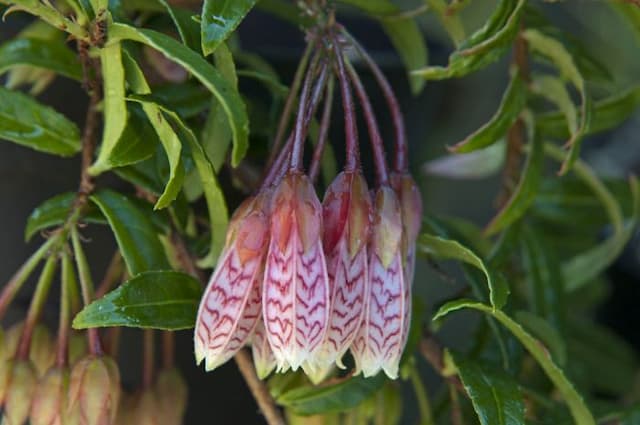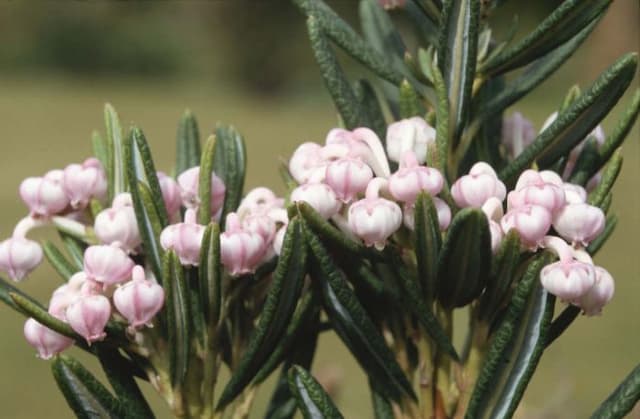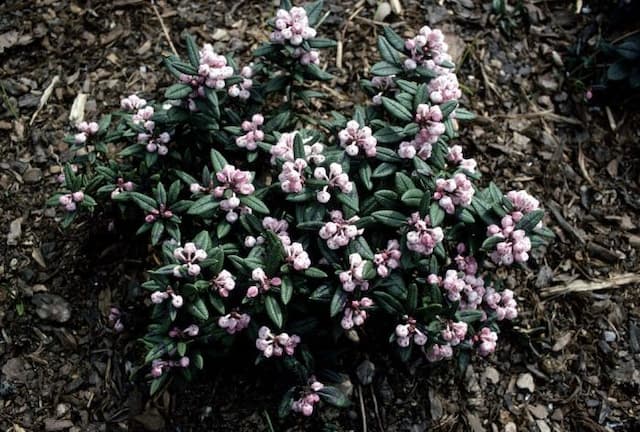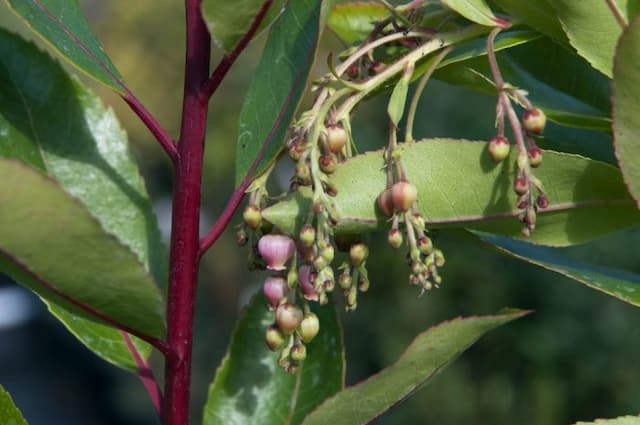Rhododendron Bow Bells Rhododendron (Bow Bells Group) 'Bow Bells'

ABOUT
'Bow Bells' is a variety of Rhododendron, which is renowned for its stunning floral display and attractive foliage. This plant showcases lush, evergreen leaves that have a glossy texture and deep green hue, providing a year-round backdrop of verdant freshness. The leaves are elongated with a leathery feel, contributing to its robust appearance. The most striking feature of 'Bow Bells' is its beautiful flowers. They bloom generously in clusters known as trusses, creating a dense and eye-catching display. Each individual flower takes on a bell-like shape, which is where the name 'Bow Bells' derives from. The flowers are soft pink in color, often with a paler throat that can sometimes exhibit a subtle yellowish tint. These blossoms emit a delightful fragrance, making the plant not only a feast for the eyes but also for the senses. Overall, the Rhododendron 'Bow Bells' is a lovely ornamental shrub that provides a splash of color and elegance to any garden setting. Its evergreen character and enchanting flowers make it a popular choice for gardeners looking to add long-lasting charm to their landscapes.
About this plant
 Names
NamesFamily
Ericaceae
Synonyms
Bow Bells Rhododendron
Common names
Rhododendron 'Bow Bells'.
 Toxicity
ToxicityTo humans
Rhododendron 'Bow Bells' is toxic to humans if any part of the plant is ingested. The entire Rhododendron genus contains grayanotoxins, which can affect the body's sodium channels and cause symptoms such as vomiting, diarrhea, hypotension, and in severe cases, coma or death.
To pets
Rhododendron 'Bow Bells' is poisonous to pets, including cats and dogs. Like in humans, the ingestion of any part of the plant can lead to serious health issues due to the presence of grayanotoxins. Symptoms of poisoning in pets may include drooling, vomiting, diarrhea, weakness, and potentially life-threatening changes in heart rate and blood pressure.
 Characteristics
CharacteristicsLife cycle
Perennials
Foliage type
Evergreen
Color of leaves
Green
Flower color
Pink
Height
4 feet (1.22 meters)
Spread
4 feet (1.22 meters)
Plant type
Shrub
Hardiness zones
5
Native area
Asia
Benefits
 General Benefits
General Benefits- Attractive Flowers: Rhododendron 'Bow Bells' blooms with abundant clusters of soft pink, bell-shaped flowers, adding a splash of color to any garden.
- Evergreen Foliage: This plant maintains its glossy, dark green leaves throughout the year, providing continuous visual interest.
- Landscape Versatility: Suitable for a variety of garden settings, including borders, foundation plantings, and woodland gardens.
- Habitat Support: Rhododendron 'Bow Bells' can provide shelter and nesting sites for birds and beneficial insects.
- Low Maintenance: Once established, it requires minimal care beyond occasional pruning and watering during extreme droughts.
- Hardiness: This plant is generally hardy and can withstand cold temperatures, making it suitable for many climates.
- Seasonal Interest: In addition to its spring flowers, some Rhododendron 'Bow Bells' can exhibit attractive autumn foliage colors.
- Pollinator Friendly: The flowers can attract pollinators such as bees and butterflies, which are important for ecosystem health and biodiversity.
 Medical Properties
Medical PropertiesThis plant is not used for medical purposes.
 Air-purifying Qualities
Air-purifying QualitiesThis plant is not specifically known for air purifying qualities.
 Other Uses
Other Uses- Ink Production: Rhododendrons can be used to create a natural dye for ink, offering an organic option for artists and calligraphers.
- Photography Prop: The 'Bow Bells' variety, with its beautiful flowers, can serve as a stunning photography backdrop for portraits or garden photography.
- Honey Production: While some rhododendrons are toxic to bees, others can contribute to the production of honey when bees forage on their flowers if they are the non-toxic varieties.
- Floral Arrangements: Rhododendron blooms are sometimes used in floral arrangements for their vibrant color and large, showy clusters of flowers.
- Wedding Decor: 'Bow Bells' rhododendron flowers can provide natural decor for weddings, either when planted in situ or used as cut flowers.
- Culinary Garnish: Although not widely recognized as edible, rhododendron flowers could be used as an ornamental garnish for culinary dishes, only if confirmed non-toxic and after proper preparation to remove any harmful elements.
- Cultural Symbolism: In certain cultures, rhododendrons hold symbolism and could be used for cultural ceremonies or traditional rituals.
- Fragrance Extraction: Some varieties of rhododendron have fragrant flowers from which natural floral scents can be extracted for perfumes or aromatherapy, though care must be taken to avoid toxic species.
- Educational Tool: Rhododendrons can be used as a teaching aid in botany and horticulture classes to demonstrate plant growth, reproduction, and care.
- Soil Erosion Control: Planting rhododendrons can help stabilize the soil and prevent erosion on slopes due to their extensive root system.
Interesting Facts
 Feng Shui
Feng ShuiThe Rhododendron is not used in Feng Shui practice.
 Zodiac Sign Compitability
Zodiac Sign CompitabilityThe Rhododendron is not used in astrology practice.
 Plant Symbolism
Plant Symbolism- Warning and Caution: Many species of Rhododendron contain toxic substances, which historically have been used to convey a message of caution or warning when given as a gift.
- Beauty and Elegance: Rhododendrons are widely admired for their stunning flowers, often associated with beauty, refinement, and elegance.
- Abundance and Wealth: With their lush, full blooms, rhododendrons can symbolize abundance and prosperity, perhaps due to their rich appearance.
- Passion and Love: In some cultures, the intense colors and hearty nature of rhododendrons have come to represent strong passion and love.
- Temperance: As a counterpoint to their potential toxicity, some have seen rhododendrons as a symbol of moderation or temperance; a reminder to proceed with careful thought.
 Water
WaterRhododendrons, including 'Bow Bells', require consistent moisture and should be watered when the top inch of soil feels dry. This may generally translate to watering once or twice a week, depending on weather conditions and soil drainage. It's important to avoid waterlogging, so ensure good drainage. During active growth periods in spring and early summer, provide about 1 gallon per watering for a medium-sized plant. Reduce watering in the fall and winter when the plant is not actively growing.
 Light
LightRhododendrons like 'Bow Bells' perform best in dappled shade. They thrive under the canopy of tall trees that provide filtered sunlight, protecting them from harsh direct afternoon sun. An ideal spot would allow for morning sun with afternoon protection, ensuring the delicate blooms do not get scorched.
 Temperature
TemperatureRhododendrons such as 'Bow Bells' are tolerant to a range of temperatures, but they prefer a moderate climate. Ideal growing temperatures for these plants are between 50°F and 70°F. They can survive minimum temperatures down to about -5°F but should be protected from hot extremes, which could damage the plant.
 Pruning
PruningPruning of 'Bow Bells' Rhododendrons is mainly for shaping and removing dead or diseased wood. It's best done just after blooming finishes in late spring to early summer, as pruning later in the season can remove next year's buds. Prune sparingly, as Rhododendrons do not require heavy pruning.
 Cleaning
CleaningAs needed
 Soil
SoilRhododendron 'Bow Bells' thrives in well-draining, acidic soil with a pH of 4.5 to 6.0. An ideal soil mix can be prepared with equal parts of peat moss, pine bark, and perlite to provide aeration and moisture retention.
 Repotting
RepottingRhododendron 'Bow Bells' should be repotted every 1-2 years, preferably in the spring, to ensure optimal growth and health by refreshing the soil and root space.
 Humidity & Misting
Humidity & MistingRhododendron 'Bow Bells' prefers high humidity levels, typically between 60-80%, which is essential for its overall health and flowering.
 Suitable locations
Suitable locationsIndoor
Ensure bright, indirect light and keep soil lightly moist.
Outdoor
Plant in dappled shade; shelter from hot afternoon sun.
Hardiness zone
5-8 USDA
 Life cycle
Life cycleThe Rhododendron 'Bow Bells' starts its life as a seed, typically requiring stratification to break dormancy before it germinates in the spring. Upon germination, a seedling emerges and grows into a juvenile plant, which develops a root system and foliage but does not yet flower. As the plant matures over several years, it enters the adult vegetative stage, during which leafy growth continues and the plant establishes a robust structure. The plant then reaches the reproductive stage, where it produces distinctive pink flowers usually in late spring, attracting pollinators and enabling sexual reproduction. After pollination, flowers develop into seed capsules that ripen and release seeds to complete the life cycle. Throughout its life, the Rhododendron 'Bow Bells' may also propagate asexually through cuttings or layering, adding to its potential for growth and spread.
 Propogation
PropogationPropogation time
Spring-Early Summer
Rhododendron 'Bow Bells' can be most effectively propagated through semi-hardwood cuttings. This process is typically carried out in the late summer, after the current season's growth has begun to mature and harden slightly. To begin, select healthy, disease-free shoots and make a cutting of about 4 to 6 inches (10 to 15 centimeters) in length, ensuring there are at least two to three sets of leaves at the top. The lower leaves are removed, and the base of the cutting is dipped in a rooting hormone to stimulate root development. The prepared cutting is then placed in a pot filled with a mix of peat and perlite or sand, ensuring good drainage and moisture retention. It is important to maintain high humidity around the cutting, which is often achieved by covering the pot with a plastic bag or placing it in a propagator. The cuttings are kept in bright, indirect light and misted regularly to prevent drying out, rooting usually occurs within several weeks to a few months.









